Alamo Group Welcomes New Outings Chair
The Alamo Group has a new Outings Chair, Andrea Rodriguez. Ms. Rodriguez is a retired meteorologist, who performed this job both in active duty at the Air Force and in federal service.
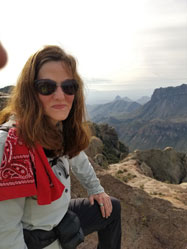
She enjoys hiking, learning about nature, and volunteering with the SA Parks, Wildlife Rescue and Rehabilitation, Government Canyon SNA, and the Albert & Bessie Kronkosky SNA. Andrea started hiking with the Alamo Group in 2013, and has enjoyed participating in many outings over the years. She tells us "I've respected and admired the folks who take the time to run these programs and am looking forward to doing my part to continue this tradition."
For the last few years, she has been leading weekly hikes in the San Antonio area and monthly hikes to Texas State Parks and other locations in the Hill Country. Andrea recently attained Master Naturalist certification (Class 46) and is a member of the Texas Land Conservancy and Nature Conservancy.
Please join us in welcoming Andrea Rodriguez to her new leadership role.
by Richard Alles, Newsletter EditorRebalancing San Antonio’s Development Codes to Reduce Runoff and Flooding
Our March general meeting features Brendan Gibbons, assistant manager of the Greater Edwards Aquifer Alliance (GEAA). Brendan will discuss how San Antonio’s Unified Development Code allows business interests to avoid mitigating increased storm run-off caused by new development, and revisions proposed by GEAA that would change this otherwise intractable problem.
Tuesday, March 15, 2022
6:00 p.m.
Online via Zoom
RSVP
To receive an email with the information you need to join the Zoom meeting, visit our event page and submit the RSVP form.
Program topic
Why does it seem that, as a community, we can never get ahead of our flooding problems? The answer lies in San Antonio’s Unified Development Code, or UDC. Currently, the code contains too many loopholes that allow business interests to avoid mitigating the increased storm runoff caused by new development.
Join us to learn how the Greater Edwards Aquifer Alliance’s (GEAA) proposed series of UDC amendments would rebalance the code in favor of taxpayers and residents, and reduce runoff and flooding.
About our speaker

Brendan Gibbons is assistant manager of GEAA. A journalist in his previous life, Brendan joined GEAA after working as an environmental reporter for the San Antonio Report and the San Antonio Express-News. Brendan holds a Bachelor of Science in science and agricultural journalism from the University of Missouri’s School of Agriculture, Food, and Natural Resources.
For more information about this program and our speaker, visit our event page.
Our general meetings are held the 3rd Tuesday of most months. They're always free and open to the public.
Carbon Capture and the Port of Corpus Christi
In the Express-News’s Dec. 23 Another View, Port of Corpus Christi CEO Sean C. Strawbridge argues against cutting back on oil consumption, saying “We cannot allow radical policies to be implemented at the federal level that hurt Texas.” He promotes carbon capture as an alternative to the renewable energy called for in the Green New Deal.
I argue, there’s nothing radical in replacing fossil fuels with renewables, unless you consider saving humanity “radical.” And it’s a pipe dream to think we can continue burning fossil fuel and simply capture and bury the carbon.
According to Bill Gates (no raving liberal) in his book How to Avoid a Climate Disaster, about 60 percent of world CO2 pollution comes from producing electricity, steel, cement, and other goods. Such production is accomplished in factories or plants, termed “point sources,” where carbon capture is practical but expensive and only about 90 percent efficient.
The other 40 percent of world carbon pollution comes from transportation, agriculture, and heating/cooling for homes and businesses. From these sources -- ships, airplanes, trucks, buildings, feed lots, etc. -- carbon capture is impractical. For such generalized pollution, carbon dioxide capture directly from the air – Direct Air Capture or DAC – is the only solution, and DAC is costly and unproven at scale.
Gates estimates the world would need 50,000 DAC plants “just to manage the emissions we’re producing right now” and that would cost of $5.1 trillion a year or six percent of the world’s economy. Gates adds, “There’s no practical way to collect $5.1 trillion a year (from individual nations) or to make sure everyone pays their fair share.” He also contends that it’s not clear that we could store hundreds of billions of tons of carbon safely.
Carbon capture may help, but it’s not the solution. Scientists tell us that the only practical way to prevent environmental disaster is to leave fossil fuels in the ground and switch to renewable energy.
One more thing. If the world continues producing its current carbon footprint, Climate Central writes on its website: “Based on the National Climate Assessment intermediate high sea level rise scenario, we project 5.2 feet of rise locally (Corpus Christi) by 2100, from a 1992 baseline.” A separate article in the Economic Pulse, published at Texas A&M University Corpus Christi, states that with six feet of sea level rise, “the city’s six oil refineries are expected to submerge under water…”
If Strawbridge wants to save all the jobs supported by the Port of Corpus Christi, he needs to start shipping something besides those barrels of oil.
by Wendell Fuqua, Alamo Group Conservation Co-chairThe Caprock Escarpment, Bison and Dung Beetles
A good place to see this geology, bison and dung beetles is Caprock Canyons State Park. This is southeast of Amarillo and northeast of Lubbock. The park's website has nature and history pages. The pictures below are from this state park.
The Caprock escarpment
The Caprock escarpment terrain marks the transition from the Llano Estacado on the west, running about north-south through the middle of the Texas panhandle. The rock is mostly caliche, calcium carbonate. The reddish colors are due to iron oxides.
American bison
This Wikipedia article notes that the American bison's species name is "Bison bison", and it is also called "buffalo" in the US and Canada. They were nearly exterminated; by 1889 only an estimated 1,091 remained. Fifty million were slaughtered in the 19th century. “This overhunting was in part motivated by the U.S. government's desire to limit the range and power of Indigenous plains Indians whose diets and cultures depended on the buffalo herds."
These men (the buffalo hunters) have done more to settle the vexed Indian question than the entire regular army has done in the last thirty years. They are destroying the Indians' commissary. Send them powder and lead if you will, but for the sake of a lasting peace let them kill, skin and sell until the buffalo are exterminated. Then your prairies can be covered with speckled cattle and the festive cowboy who follows the hunter as the second forerunner of an advanced civilization.
Caprock Canyons State Park is the home of the Texas State Bison Herd.
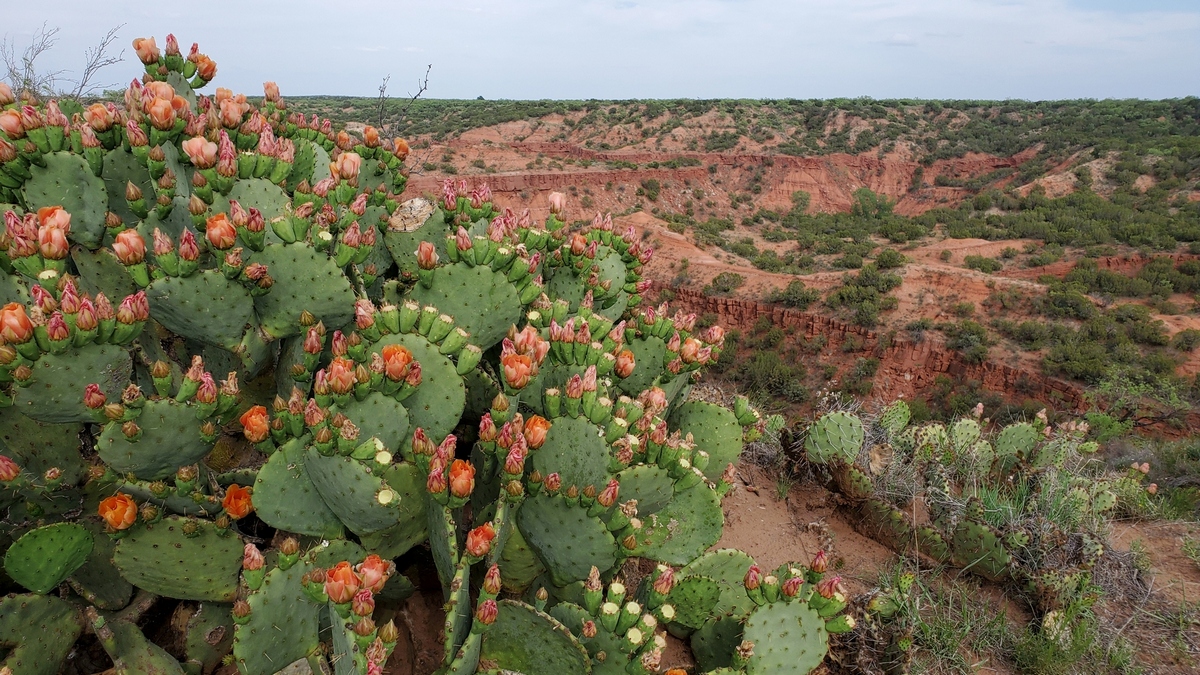
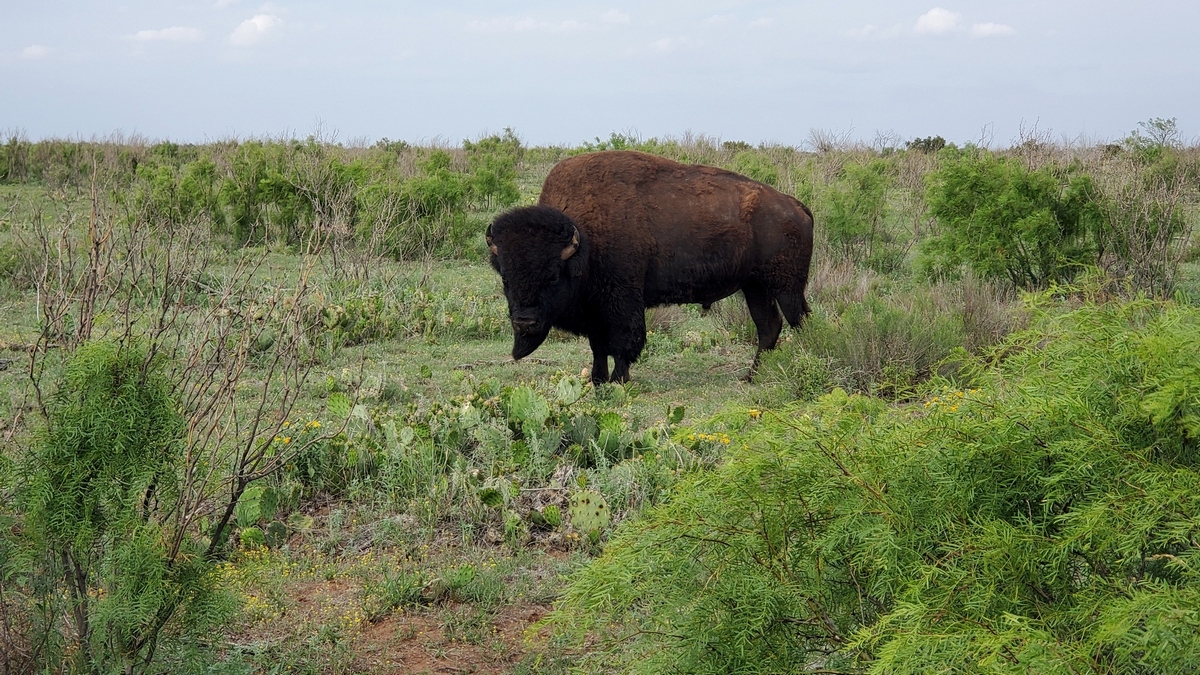
Dung beetles
Our group saw a lot of bison poo along with the bison. On the Canyon Rim trail there were many deposits that were being harvested by dung beetles. We figured could find some articles explaining all this. Back at the campground we had good cellular data signal, and soon were exchanging insights about dung beetles between tents. Here's the Wikipedia article and a TX A&M page.
The beetles do important cleanup work after the bison and other large animals. Apparently they cooperate rolling dung balls if are a pair intending to mate, or if both are females one may try to steal the other's ball. The beetles posing for the picture below wouldn't provide details, though there appears to be quite a harvest in process.
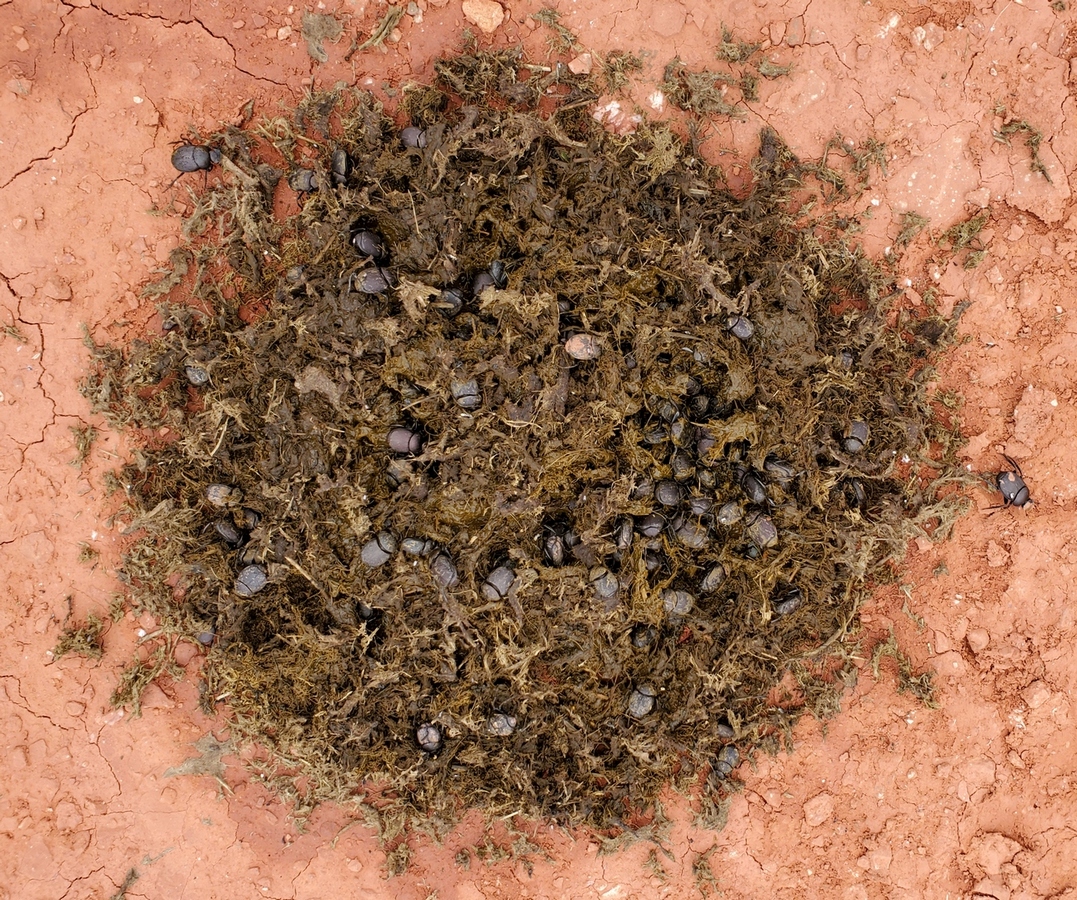
In the next picture we can see the valley resulting from waters following the course eastwards from Fern Cave and then channels like the one in the final picture. On a map I see the watercourse is labeled North Prong Little Red River. Where does this go?
A search found a map showing that this joins South Prong a bit east; then Little Red River joins Prairie Dog Fork of the Red River, which becomes the Red River proper west of Wichita Falls. Red River runs to the Atchafalaya River. The latter flows to the Gulf of Mexico though it was engineered and diverted in the 20th century. The Red River basin is the second largest in the Great Plains; I guess the largest is the Missouri.
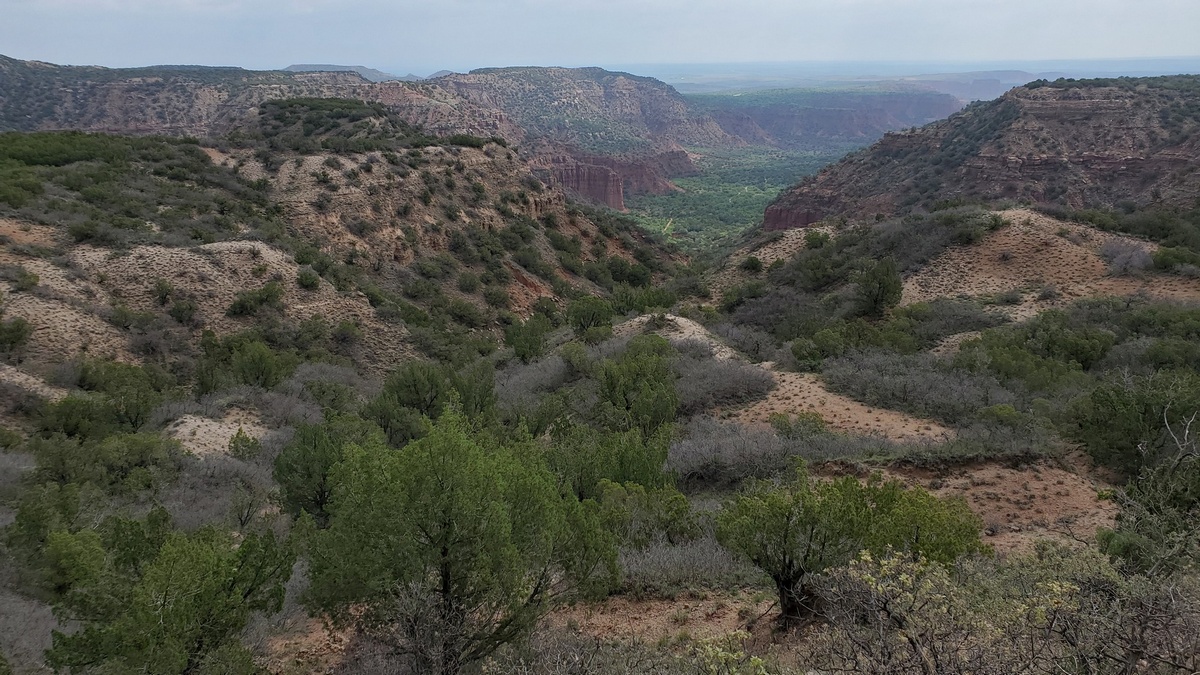
What is labeled Fern Cave on the park map, the next picture, is at the far west end of the loop mentioned in the above picture's caption. I found many better pictures with a search, but in mine we can see what might be the mouth of a real cave. The search produced this link about a real slot canyon above, which says "Exploration in the rugged wilderness above Fern Cave is dangerous.
This canyon contains large vertical drops navigable only with the aid of ropes. Few avid hikers of the Llano canyons have descended into the depths of this treacherous canyon.” This is not mentioned on the park website.
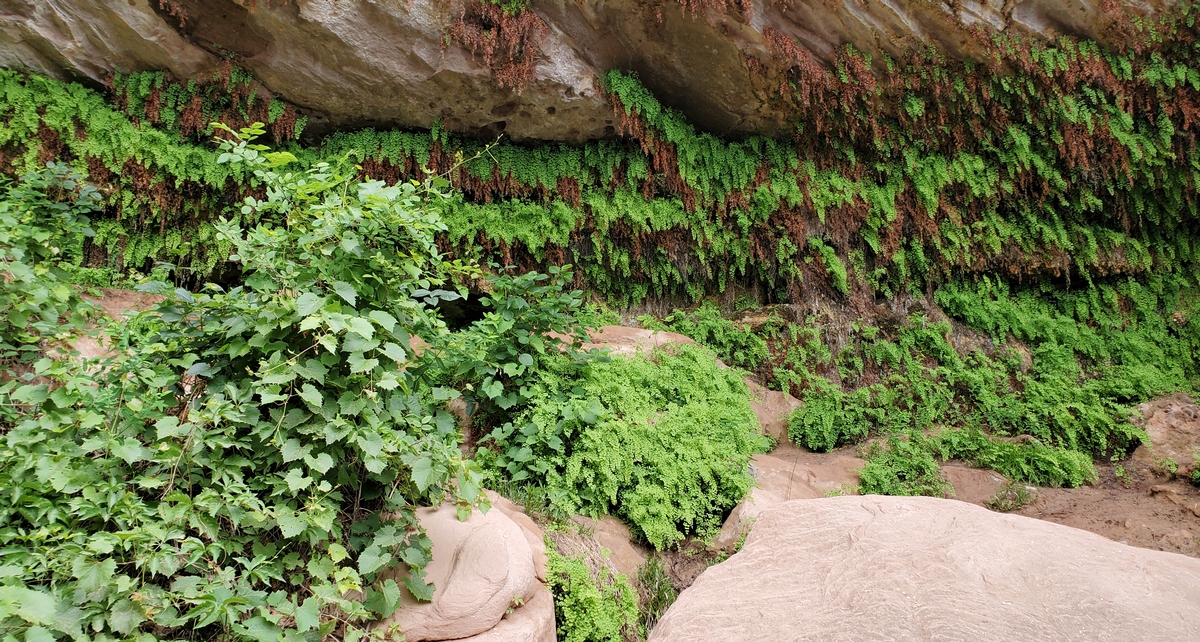
The picture below is one of the channels comprising the North Prong Little Red River drainage. This is from North Prong Spur trail, which is the east side of the loop mentioned in the previous two pictures. A bison was wandering south along the trail; happily it went off to the east not concerned about us.
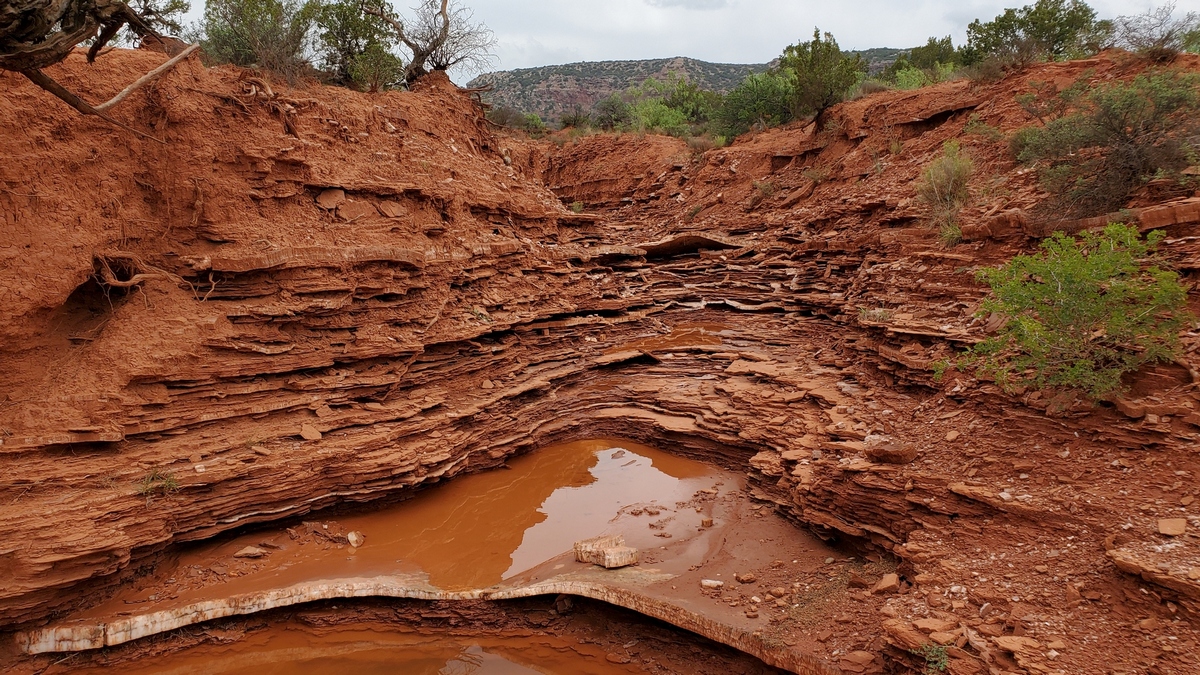
From the e-Mailbag
From time-to-time, the Alamo Group receives messages concerning local environmental issues. If you have thoughts to share on any of these issues, send us a message and we'll forward it to the writer.
The views and opinions expressed here are those of the authors individually and do not necessarily reflect the views or opinions of the Alamo Group or its members.
City OKs shopping center in floodplain
There is a development by Abiso LLC to construct a shopping center (The Shops at Babcock) at the southwest corner of North 1604 and Babcock. Over 8 plus acres (in the floodplain, over the Edwards Aquifer Recharge Zone) have been cleared of cedar and oak trees.
Environmental Impact Studies are not being made available under the claim they are privileged information. The online application to replat this property indicates Karst Features- "Yes", Impact to Habitat- "No."
There are a total of 19 plus acres where this development will take place. Unfortunately, the City has entered into a Consent Agreement with the developer to permit enforcement of a less restrictive tree ordinance and payment in-lieu of preservation.
How can we gain transparency, or validation of the results of the environmental study if the City fails to disclose it? We seek your guidance as it's a matter of time before more fully mature cedar and oak tress are cleared, impacting the environment and habitat (golden cheeked warbler).
Editor's note: This project is discussed in a recent Express-News story, Environmentalists push tight limits to build in floodplains — and developers aren’t happy about it
Proudly serving
Congratulations to Alan Montemayor on being re-elected as Vice Chairman of the San Antonio Water System's Community Conservation Committee.
submitted by Rachel CywinskiTake action to pass climate legislation and funding
This webpage, hosted by an Interfaith coalition, provides a simple way to effectively advocate for climate action funding with your elected members of U S. Congress. It will be operating until mid-March.
Breathe again. Healthy air is health care.
submitted by Rachel CywinskiSustainable, Free, Nutritious Veggies!
This is nopalito; the young tender pads of prickly pear cactus. The pictures below are of a hybrid developed by Luther Burbank specifically for agriculture. The pads can be harvested pretty much thoughout Spring. Cultivation effort is nearly zero; doesn't need water or fertilizer. The collection and preparation might seem daunting but actually is simple and can be painless.
The variety pictured has no spines, only tiny hairs. Harvest with gloves. Preparation involves holding pads down on a chopping board with a washrag and scraping the eyes with a knife, which removes the hairs. Trim the edges and rinse. Slice and dice.
Sliced it is used in Mexican restaurants after boiling, rinsing and frying. I like it diced for use in sauteed mixed greens, chili, soups, gumbo, and fried with meat/eggs for tacos. Works like okra; so particularly in soups and gumbo the slimy liquid is useful. Freezes well. There are lots of web pages about all this; here is one.
Nopalito is very nutritious with various additional health benefits, including reducing cholesterol, and having antioxidant and anti-inflammatory properties. Here's a web page.
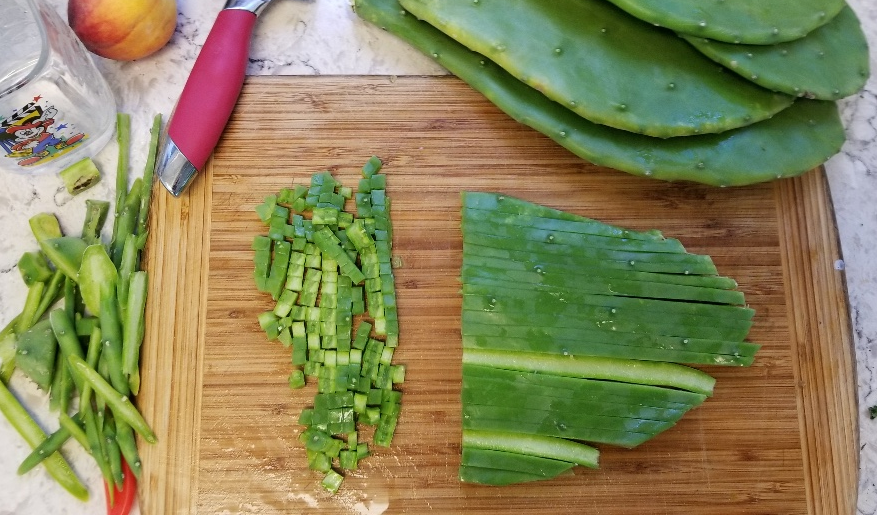
The hybrid variety, as likewise the native Texas prickly pear, are easily planted and propagate by dropping some pads each year which root and on they go. The hybrid seems to do better in the Hill Country than the native species; the latter seems to not be happy with heavy rains. I have seen places where the hybrid had become invasive, as some other agricultural crops might be. With regular harvesting this is not a problem.
In Kerrville it got down to 6 degrees during the February 2021 storm. The larger, older plants on my property at least partly died as the stems rotted, but the younger ones did well and will be ready for harvesting again beginning March.
If some folks would like some mature pads (we might call these nopal viejo) for planting e-mail me. I might manage to bring by 1,000 pads for sharing around our community.
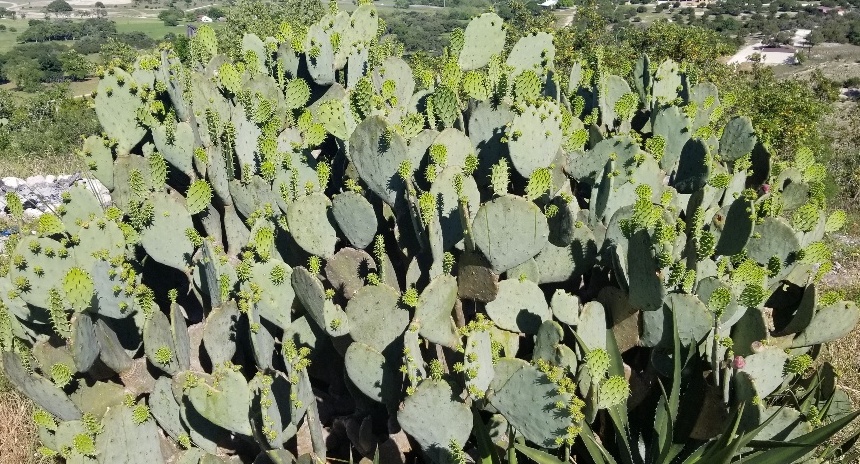
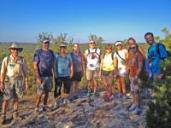
Outings: The Call of the Wild
Visit the Alamo Sierra Club Outings page on Meetup for detailed information about all of our upcoming Sierra Club Outings.
The Alamo Sierran Newsletter
Richard Alles, Editor
Published by the Alamo Group of the Sierra Club, P.O. Box 6443, San Antonio, TX 78209, AlamoSierraClub.org.
The Alamo Group is one of 13 regional groups within the Lone Star Chapter of the Sierra Club.
Changed your contact information?
If you're not sure whether the Sierra Club has your current email address, send an email to Member Services with your name and address and/or member ID (see Locating Your Member ID) so they can add your email address to your member record.
Have you moved? Let us know by sending your old address, your new address and your member ID to: address.changes@sierraclub.org.
Go online for the latest news and events
 |